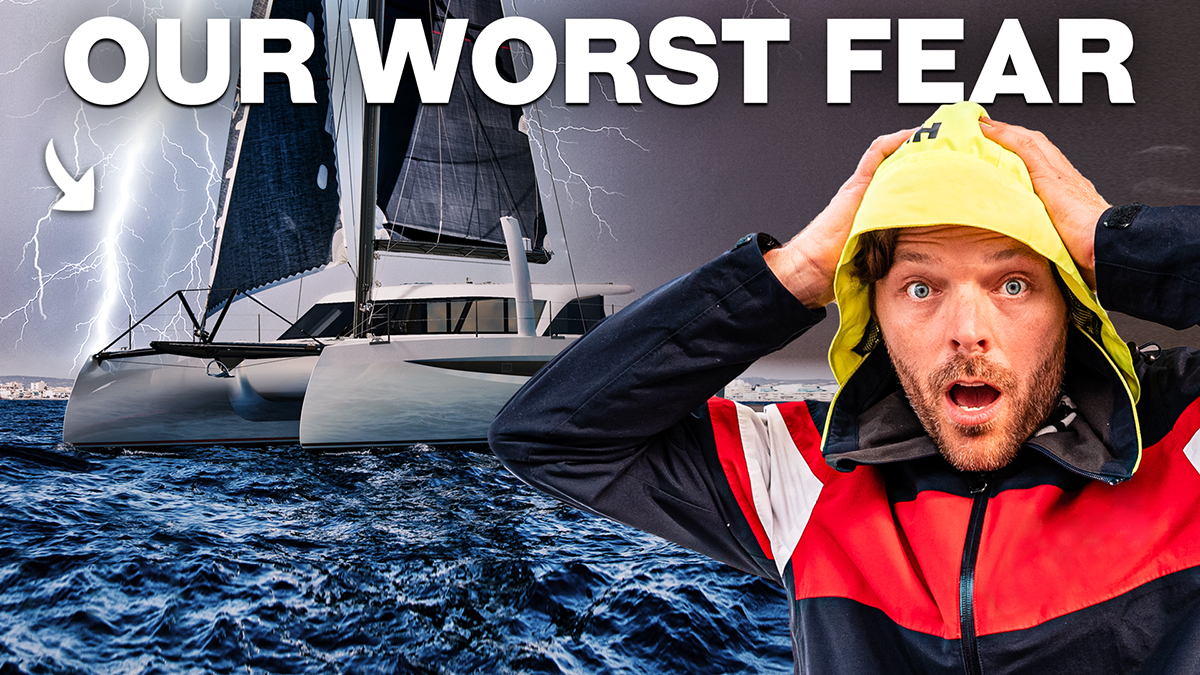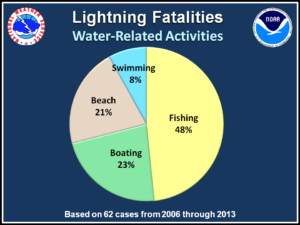
⚡Lightning And An Electric Boat?
Lightning damage isn’t something that keeps us up at night, but just the thought of getting struck makes my heart sink to my stomach. Because it’s not something we can escape or avoid. It can be fatal at worse and kill our electronics at best.
Now here we are, building a hybrid electric catamaran with an all-electric galley and a whole bunch of other fancy electronics that we would like to keep shiny and new for a long time. This means we’ve been doing a ton of research on lightning protection, strikes, and the aftermath of a strike. And, as the old saying goes, an ounce of prevention is worth a pound of cure. So, in this video, we visit a couple of boats recently hit by lightning to get some firsthand experience and check out the latest lightning prevention tech that is making some very bold claims.
Opinions and claims fly from all directions about lightning prevention on a sailboat. But the reality is, we haven’t found a solution that is recommended by the insurance companies or one that they are willing to give a discount on for installation…which says a lot. After filming this video we spent days that led to weeks researching all the current options. We know more about lightning than we ever wanted to know. And sadly it seems a lot of solutions are just snake oil.
The answer seems simple to us. There are ways to recreate lightning in a lab. If a company wants to prove its lightning prevention system works, all they need to do is take it to the lab and film what happens. Or maybe I’m oversimplifying and expecting too much? If the Sandia National Lab could simulate lightning in 1982 and fire it at an F14 Navy Fighter Jet, why can’t we take a little aluminum dome and blast a lightning bolt at it?
Loose Cannon wrote some interesting articles about both systems and his findings only cause more concern:
- https://loosecannon.substack.com/p/sportfishing-giant-adopts-experimental
- https://loosecannon.substack.com/p/nasas-go-to-lightning-guy-disses
In other words, we’re still not convinced about any lightning prevention options yet. And until we are, our best protection is grounded in a good insurance policy.
Lightning & Hybrid Electric Engines
The Ecodrive on our new HH44 is a parallel hybrid (more on this soon), not a serial hybrid with electric motors relying on a generator. And our parallel hybrid is built on two separate mechanically aspirated diesel engines, not an electronically computer-controlled common rail system such as the Yanmars mentioned in the video. What does this mean? Should the entire boat ever be fried from a lightning strike, our engines will still start and we can motor along to safety.
🎥 CAMERA GEAR USED TO FILM THIS VIDEO
🎶 MUSIC & SOUND EFFECTS IN THIS VIDEO
- Get 2 Months for FREE: https://bit.ly/artlist-GWTW
- Artists – Sunny Fruit, Rex Banner
🙏 WE COULDN’T MAKE THESE VIDS WITHOUT YOU!
Thank you for watching! Ups, downs, and all around, we share it all. If you like what you see, there are lots of ways you can show your support.









Mike Eppright
Airplanes use static wicks to dissipate the charge. Is there a way to wire the boat to, with the flip of a switch, remove the ground from the electrical system for a short time during storms to protect any electronic or electrical systems? Lights out might be temporarily better than a gigantic insurance claim.
Jim
Further information from the rectangle of knowledge – Perhaps researching the work of Prof. Ewen Thompson from Florida would bring some comfort. He went as far as producing a product: http://www.marinelightning.com/index.html#Introduction. There are “standards” see ABYC TE-4 Lightning Protection. (buy it here: https://abycinc.org/store/viewproduct.aspx?id=14489715&😉 or first look at some summary like this: https://newboatbuilders.com/pages/electricity14.html. It really comes down to cost. Lots and lots of Military Systems are designed to withstand direct lightning strikes and induced EMI pulses but it is costly. For example that USB charging cable hanging about to pick up a pulse is worth about $0.75 to make – a properly shielded and bonded connector maybe $10. And so on for all the consumer grade electronic stuff you have onboard.
Mary Van
It is good to know that your phone can help navigate if you were shut down by lightening. I guess that would be if you were within range.
I hope it doesn’t happen to any of you! It was a long process and more difficult from the sea I feel sure!
Alan Solomon
Hey Wynns. I am a day late viewing your latest. As usual the subject and content is awesome and very informative.
I do not have any experience with lightning although, I do have a secret pertaining to lightning which, I will not speak of now.
When Sandra and the 2 Spaniels mentioned that California does not experience lightning my mind immediately went into action. The National Weather Service, (NWS) reports that most “naturally caused fires and wildfires in California start from lightning especially where the ground is dry and easily ignited.”
Considering that the HH will be your home for likely a few more coming years and considering that the technology is available, and it is affordable then I would get it for sure. Thank you, Happy and Joyous.
Erik Ranger
Curious about the effect of a carbon mast with non metalic ie aramid stays? Yes you may have an antenna at the mast top and a wire coming down the interior of the mast but still any change?
Erik Ranger
Taos New Mexico
Jim
Hi Wynns!
I’ve researched the lightening issue myself, as I am an Amateur Radio operator who is responsible for installations on mountain-top antenna-tower sites. There IS a lot of research on lightening and surviving. The Loose Cannon articles you cited provide a lot of good info: there ARE conventional lightening protection systems. They do NOT prevent a lightening strike, but substantially reduce or eliminate damage from one. Michael, above, mentioned some pieces of a successful system, but didn’t cover much of the WHY it works…
The key is GROUNDING and BONDING. You must do BOTH, and that drastically reduces lightening-related damage, especially damage from nearby lightening. This IS science that is well documented, and is based on the same science cited in the Loose Cannon articles by the engineer who designed the system for NASA. Here’s what it means and why it works:
Voltage can be thought about as “electrical pressure”. Pressure must always be measured against a reference, and so does voltage. That’s why voltmeters have two probes…Its the DIFFERENCE in POTENTIAL (pressure) between two points. Lightening damage happens when that voltage potential increases beyond the “breakdown voltage” of the electrical components — in other words, an electrical line got too high a pressure and “blew through the component”.
Nearby lightening damage happens from “induced voltages” — much like the school electromagnetic demonstrations of putting a wire in a magnetic field creates power. The electrical field from a lightening strike somewhere generates power in metal conductors (most damagingly in wires, but could be in anything metal) in your (boat/house/rv/radio tower/whatnot). If those voltages (remember, voltage is a measurement between two points!) get above the maximum tolerable, then the component fails.
If you BOND everything together, then the voltages tend to rise together. The lightening can raise the voltage above what it was substantially, but if everything increases at about the same amount and time, then the DIFFERENCE between two points remains within the components tolerances, and damage is averted.
GROUNDING is the second point. You do need a place for this energy to go. If too much energy tries to go through too small of a path (small wire, or even traces in a circuit board), it can literally melt out parts of it, causing a failure. So you want a good, heavy duty path to ground that can survive the energy surge and transfer it to “ground”.
What does this look like practically? First, we need a good ground. That’s the metal blocks that were installed on the boats in your video on the hulls. We need heavy duty wire connecting the two together. We need this wire to be available in the boat to anything else that you need to ground (like your mast, and standing rigging). You also want to connect to to any existing ground wiring (the ground plug on your AC power system for example). You’ll also want to attach any lightening arrestor to it. For any cables that have “shields” like radio antenna wire, but also could be sensor wires that are wrapped with a foil inside), you’ll want to attach that shield to ground at least at the radio/electronic device, but also if possible at the bottom of the mast. You’d also want to put lightening suppression in the same spots. Finally, you’ll want to ensure anything with a metal case that is electrical / electronic (including things like your inverters!) have that “ground” lug used and attached to this grounding system. It is MOST IMPORTANT that all grounds are firmly attached together (through the big ground wire is fine). You should never be able to measure a voltage from one device’s metal case to another if bonding is done correctly. Finally, you PROBABLY should bond your DC – (negative) lead to ground. You will need to confirm with your electrician with specific knowledge of your boat’s systems to confirm this. You’d want lightening suppression on your + (positive) lead at “key points” (say, inverter input, and if the batteries are a distance away, at the batteries).
I mentioned Lightening suppressors a lot. These are devices that have an in and out (“pass through”) and have a ground connection. They are designed to allow “normal voltages” to pass through in to out. In the event that the voltage differential between the signal and ground exceeds some amount (typically relatively large, but differs by lightening suppressor and purpose), it will short the signal wire to ground to allow that power to be dissipated to ground. Normally when the voltage surge is over, it returns to normal, but if the amount of power is too great, some devices will fail, requiring replacement. Many (such as those used to protect radio antennas) have easily replaceable cartridges. Typically cost of replacing these suppressors if necessary is <$1,000, an easily justifiable expenditure. Typically replacement is only required in very near or direct lightening hits.
For radio towers (what I did most of my research on), Michael's post was pretty accurate…we dig a trench around the tower, put some graphite in the trench (to enhance electrical conductivity, place a large bare conductor, preferably copper (often up to 1" in diameter). We then use "thermal explosive bonding" to permanently weld connections to each tower leg, and optionally a dedicated grounding location. If there's an equipment building near the tower, you do the same thing at the building. For all the antenna feed lines on the tower, you apply a shield grounding kit and bond it to the tower frame as near the antenna as you can, and again at the base of the tower. At the building entrance, EVERY conductor that enters the building that isn't itself a ground is run through a lightening arrestor that is connected to ground (usually using a 6 gauge or better wire, or flat copper sheet). The lightening arrestors also bond the shield to ground (yet again). Inside the building, EVERYTHING METAL has heavy gauge wire or "grounding straps" bonding the metal to the building's grounding system. This system will protect against most lightening events. Direct strikes to antennas can require the antenna itself to be replaced due to melting or otherwise physically damaging a portion of the antenna, but the electronics will typically survive.
One last comment: It was mentioned in the video that there was no lightening protection when the boat was on the hard. That is simply because the salt water and metal plates on the hull were your ground. Now those metal plates are in air, and are not connected to anything. If your boat is going to spend any reasonable time on the hard, you should just drive a ground rod (obtainable at most home improvement stores) into the ground, and attach a grounding strap or heavy wire between the ground rod and the metal plate on the boat. Ideally you'll drive a separate rod for each metal plate (2 were shown on your video), and now you have the same protection on the hard you would have had in the ocean.
Since you mentioned an RV in the video, similar principals apply. Since an RV frame is metal, and most things are already bonded to that, you're most of the way there. The missing piece is a ground. Since the RV is on rubber tires, there's no good ground conductor (and the little ground wire on a shore power connector is not adequate for lightening suppression, even if the ground was well connected at the time of the strike). So, if you're seriously concerned, whenever you park, drive a ground rod in, and hook the frame to the rod. When you're ready to go, disconnect and go. Retrieving ground rods from the ground can be challenging, though! And of course, its critically important that everything is actually bonded to the vehicle frame well.
None of this prevents lightening strikes, but it substantially reduces the damage a lightening strike would do. In most cases, it does prevent damage all together except in the most extreme cases, and often, that damage occured because the grounding system was not large enough. However, there's diminishing returns and at some point, you need to call it "good enough".
Jim
Sorry, one edit: the cost of replacing lightening suppressors for an entire facility/boat/etc is usually under $1,000. Most are under $50 each.
Michael
Sorry, Jim, but I thought I pointed out the why. It drains the negative ions away from building up enough to create the down strike. Obviously, if enough is drained away, the creation of a lightening strike is eliminated, since the down strike pathway does not exist.
By the same token, the Faraday cage technique makes sure the pathway goes to the ground and the internal space is protected. (The van that Mary uses is a metal shell, or Faraday cage, so she was protect because she was not touching metal. Some people drag a ground cable around with them or drop one on the ground while parked to maintain a ground to override the insulation of the tires.) You rightly implied the aspects of an EMP, which the Faraday cage also helps eliminate. We all should know by now that any nuclear event will make any automobile with electronics simply stop working, and those effects are wide ranging.
The key is to make it easy to bleed off the potential energy before it builds up. With that said, I believe we can understand the benefits from using both systems as one all-encompassing solution. Stop lightening from creating a path and also protect internal electronics. In other words, a lightening suppression system thru a Faraday cage as well as internal protection. I do not know is the Tesla coil type of device at the top of the mast is the best attracter of negative energy or not. If it is, then we should use it as part of the total system. (Would Franklin’s method have been better with it?)
Oh, by the way, never, ever use any electronics without surge suppression. In all my years in computer technology, it became obvious to me early on that surge suppression is fundamental. However, we must consider the different parts of damaging current. My example as I mentioned failed to indicate that there were huge fuses in the cable tunnel, but lightening jumped them and they did no good. This is the extreme flow that cannot be controlled at that point. It is simply too late. Preventing the high surge by preventing the strike in the first place is paramount, as Jim and I indicated. However, we will not want to ignore surge suppression and brownouts either. Both are damaging, and at the very least in the long term with regards to brownouts. An uninterruptible power supply (UPS) is always a good idea, and no electronics should be powered without them. One’s battery bank can be one part of that UPS system, but the quick switchover protection must also be in place for the health of the electronics.
As to insurance coverage, a good UPS or at least a surge-suppressor will have monetary compensation warranties to cover any damages. Just make sure the coverage is adequate, or break down the electronics into sections with separate coverage. Your insurance carrier should not be involved, and these devices can never deny you future insurance coverage.
Mary Van
Good information!
Mary Van
Good Information!
Loose Cannon
https://open.substack.com/pub/loosecannon/p/proven-lightning-protection-that?utm_source=direct&r=nzq2r&utm_campaign=post&utm_medium=web
You probably should have read this one to. It’s a system that seems to work.
Tom Fitch
This was a REALLY interesting video – well done! I live in the mountains and many homes high up have “lightening rods” installed on the roofs with copper cables going to ground at each corner of the buildings. Of course, probably impossible on a boat where the sails need to swing all around. Jason, I would love to know who Mary has her insurance with! My renewal just came around and I have to do some shopping!
Mary Van
State Farm. Will and his team have been so easy to work with.
Michael
Always trust Nicola Tesla. The Tesla coil has been around for over a hundred years. I’m convinced it is a good idea.
I also have knowledge about the university radio station I worked at. They kept getting knocked out because of lightning strikes. It would travel over a quarter mile thru their underground cable tunnel and fry the indoor mixer panel while the announcer was on the air. That’s a long ways. And no one liked sparks near their finger tips.
They finally dug a trench around the tower at approximately 100 feet radius in which they laid a buried metal loop. From that they connected radiating wires to the base of the antennae. Then the negative ions were drained away from the tower before any down-spike could form. (I was once in the little shack at the base of the antennae, and you should see the 8-10″ copper plate across the floor for grounding in that little shack. Never stand on that!)
Does it work? You betcha!
As long as you can get enough ground in the water, you should be good to go.
Yes, it costs, but maybe financed into the purchase price might not be too bad.
By the way, unless there is a direct strike, I cannot imagine a motor vehicle getting hit. It sets on insulating rubber tires. If a person is in a car with a downed power line laying across it, as long as no one touches metal, they should be safe.
Bonus info: Can you find an inexpensive coil to mount on the mast? There must be an outlet for that sort of thing. A lot of research uses those. Maybe get a university engineering department to help with the specs. Anyone can run the wiring.
Thanks.
Sandra & the 2 Spaniels
Yikes! Lightening is something we just don’t think about in California, as it is so rare. Even up in the Sierras, you can get drenched, frozen, or dangerously fall-but no one worries about lightening. It is rare to see a strike. Now in the Midwest and South-a whole different ball game. Even horseback riders need to be careful. Even if unproven, so to speak, I would put one of those prototypes on a boat. At least it is something.
Jan
Not true. I live in Ca west coast east and central. Lightening mid summer every year. Least on the coast but it is there. Lots of fires. I had fires on a large property I lived on in eastern sierras nearly every year for 22 years. It was prone to strikes. I also know a guy who was hit by lightning in the sierras. I been stuck in lightening while hiking many times in the sierras. Is it as much as the east coast storms? (I have lived there) no.
I am guessng you just live in an area that may not have much lightning. Which is good!
Good luck to the Wynns. The new boat should be all speced out great by the time you get it!! Very exciting.
Bill Berry
I will avoid the “Electrifying” comments, and just say interesting and informative video. I imagine lightening strikes are just something you just hope never happen, because it can only be seen after the fact. They happen for everyone, but rarely does one think about until the lightening flashes and something fritzes. They happen though to everyone Landlubbers such as I Aviators, Space Shots, Farmers, Zoo’s and yes even Seafarers such as yourselves and the people you interviewed. I shudder to think and it was not mentioned Electric Propulsion Systems. It was spoken of the new Yanmars with the computerization for controls and how the Yanmars pre-computerization are immune, Now many of you trying to go Electrical drive what a hit that would be (No pun inteded) to the espense and your Insurance if you were struck.